Imagine a world where every customer leaves your store, feeling satisfied and eager to return. This utopian scenario is the dream of every business owner. However, it’s not just about wishful thinking; it’s about understanding the key metric to make this dream a reality – the customer satisfaction score (CSAT).
Customer satisfaction is not just a feel-good metric; it directly impacts a business’s bottom line.
In this article, you will explore the realm of customer satisfaction and how businesses can leverage it to create a loyal customer base.
Table of contents
- What is the customer satisfaction score?
- Why measure CSAT score?
- Benefits of measuring customer satisfaction
- When to measure customer satisfaction score?
- How to measure CSAT score?
- Tips on crafting effective survey questions
- What is a good CSAT score?
- How to calculate your CSAT score?
- 6 Customer satisfaction metrics to start measuring
- 5 Best practices for customer satisfaction
- 2 CSAT alternatives: CES & NPS
- How to use CSAT as your differentiator?
- Case study of customer satisfaction done right with Birdeye
- FAQs on customer satisfaction score
- Scale your customer satisfaction with Birdeye Survey
What is the customer satisfaction score?
The customer satisfaction score, or the CSAT score, measures customer experience. When you want to understand your customers’ happiness, you can send them a CSAT survey to gather feedback on your products, services, or customer behaviors.
Respondents are given five to 10 options. In other words, a five-point or 10-point rating system.
Most questions in CSAT surveys are usually as follows:
- On a scale of 1 to 5, how satisfied are you with our product/service? - Please rate your overall experience with our customer support from 1 to 10. - How likely are you to share your positive experience with others? - Did our product/service solve your problem effectively? - Would you consider purchasing from us again in the future?
Build Customer Feedback Surveys that Yield Results
Want to see the impact of Birdeye on your business? Watch the Free Demo Now.
Why measure CSAT score?
Measuring CSAT scores is vital because:
To estimate team performance
Measuring CSAT scores can help you better understand how your team is performing. It can also uncover whether your support team requires additional training.
Gain valuable insights
CSAT surveys are easy to deploy and, even better, easy for your customers to answer. Survey results can shed light on areas to improve, and if you focus on these areas, you can continually uplevel customer satisfaction and success.
Uncover what your customers are or aren’t happy with
Surveys can offer additional insight into the specific aspects of your products and services. The more detailed the response, the more you learn how your customers feel about you and what you provide.
Benchmark customer satisfaction
You can benchmark your progress and see how you’re doing over time by sending out the same survey periodically. This long-term data can also help you identify areas of your business that you’re improving, not improving, or not addressing.
Improve customer loyalty
Asking for feedback makes your customers feel valued. And if you take steps to improve customer success, your customers will feel like you care. This fosters more customer loyalty.

Benefits of measuring customer satisfaction
If you’re wondering why CSAT scores matter in business, it is because it has a lot of benefits.
Enhancing customer satisfaction through improved service and support
If there are any gaps in your customer support efforts, CSAT scores should reveal them. Addressing these areas in your business on an ongoing basis will mean more goodwill toward your business long term.
Cultivating a customer-centric culture within your organization
While catching up on key performance indicators and bottom-line revenue is easy, fostering a customer-centric culture first will lead to the best outcomes. Put the customer first, and everything else will fall into place.
Leveraging technology to boost customer satisfaction
Technology can help you and your team spend less time on the minutiae of repetitive tasks and focus on enhancing customer experience. Consider implementing the following to boost customer satisfaction:
- Live chat
- Chatbots
- Co-browsing
- Mobile apps and responsive websites
- Analytics tools
- Social media listening tools
Effective handling of customer complaints and feedback
Every business ends up with complaints and negative feedback from time to time. What matters most is knowing how to handle it.
And if you can identify themes in your data, you will have a better understanding of why certain customers are complaining about certain issues, improving your overall effectiveness in responding to feedback.
Did you know: According to Hüify, acquiring a new customer costs five times more than retaining an existing one. Measuring customer satisfaction will help ensure your existing customers stay with you.
When to measure customer satisfaction score?

Customer satisfaction scores should be measured at strategic points in the customer journey. Here are some key moments when it is beneficial to measure customer satisfaction:
Before they renew
Send the survey six months before they renew, which should give your business sufficient time to fix problems and increase satisfaction.
After interactions with customer support
It is common for companies to survey their customers after a support interaction. By collecting feedback at this stage, you can better understand how customer inquiries are being handled.
After hitting a milestone
If customers have stayed with you for long periods of time, it means you’re doing a good job. But that doesn’t mean you couldn’t be doing a better job, and surveying customers and understanding their customer journey after they’ve hit certain milestones can be enlightening.
After customer lifecycle moments
Measure customer satisfaction after critical moments in their customer journey, such as post-onboarding, during the renewal period, after they’ve upgraded to a more advanced plan.
After special promotions or events
After running marketing promotions, events, or special campaigns, measuring CSAT can help determine their effectiveness and how they impact customer satisfaction.
Post-feedback implementation
If you receive feedback from customers and take specific actions to address their concerns, measuring CSAT after the implementation of these changes helps assess their impact on customer satisfaction.
How to measure CSAT score?
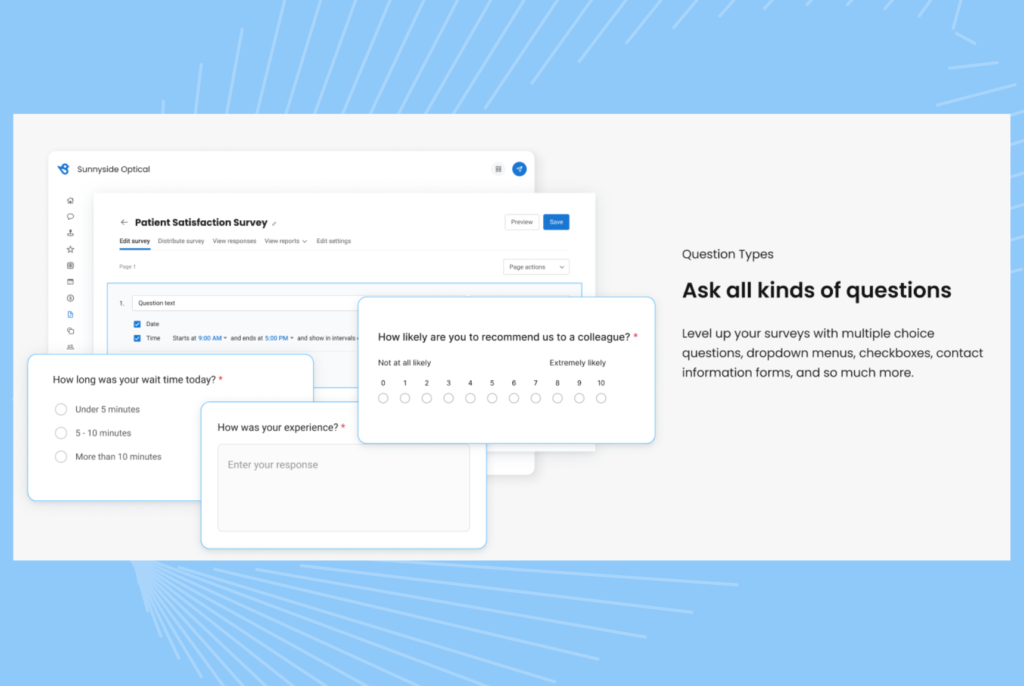
Measuring CSAT scores involves collecting customer feedback to assess their satisfaction level. With Birdeye, you can measure all major forms of satisfaction scores, like:
A. CSAT survey
CSAT survey allows your audience to rate your business on a five-point or 10-point scale. Questions that rate customer service are often built into live chat software, but you can also use tools like SurveyMonkey or Jotform to survey your customers.
B. Net Promoter Score (NPS) surveys
NPS surveys measure customer loyalty and satisfaction by asking customers to rate the likelihood of recommending the company to others on a scale of 0 to 10. Based on their responses, customers are categorized as Promoters (9-10), Passives (7-8), or Detractors (0-6).
C. In-app or website feedback
Some businesses directly integrate feedback forms or pop-ups within their apps or websites to capture real-time customer feedback after specific interactions or transactions.
D. Customer service metrics
Tracking customer service metrics, such as average response time and first-contact resolution rate, can indirectly reflect customer satisfaction with support services.
Tips on crafting effective survey questions
You can do several things to ensure you’re asking effective questions. Consider the following:
- Ask more closed-ended questions.
- Ensure the questions are neutral.
- Ensure the answers are balanced.
- Don’t ask two questions at once.
- Space out questions that look similar.
- Make most of your questions optional to answer.
Collecting survey data should be easy if you only use one tool to collect it. Take advantage of Birdeye’s Survey to manage and keep your feedback organized.
Surveys utilizing ratings alone should be easy to analyze, but otherwise, it is recommended that you follow customer feedback analysis best practices to make the most of the responses you gather.

What is a good CSAT score?
The American Customer Satisfaction Index has benchmark statistics across a range of industries. Here are some examples that are relevant as of 2022:
- Healthcare (nonhospital care) – 73.
- Financial advisors – 79.
- Automobiles – 78.
- Life insurance – 78.
- Health insurance – 73.
You can refer to these statistics and others to understand how your company measures up in your industry.
How to calculate your CSAT score?
The customer satisfaction score formula is easy to follow. It takes the form of:
(Satisfied customers/number of responses received) x 100 = your CSAT score
For instance:
If 132 customers voted 4 or 5 stars out of the 151 customers that were surveyed, your customer satisfaction score would be:
(132 / 151) x 100 = 87.42%

6 Customer satisfaction metrics to start measuring
- Survey bias. Encouraging certain answers over others can make for unreliable data.
- Question design. When creating a survey, all factors must be accounted for, or you may not be collecting the feedback you need to assess relevant challenges and make improvements.
- Low response rate. Not getting the number of responses you need to make an accurate situation is always a problem. Growing your audience is usually the solution.
- Survey fatigue. Too many surveys can tire your customers out. After all, you are asking for their time. Incentivizing customers can help.
- Benchmarking and comparison. There are many challenges associated with benchmarking and comparison. For instance, a business on a growth trajectory will have more customers now than it did six months ago, making benchmarking data less reliable.
- Interpreting open-ended responses. Proper customer feedback analysis tools and resources will need to be employed to make better sense of open-ended responses if there are any opportunities at all.
- Actionability of feedback. You may not be able to act on the feedback you receive. For instance, maybe the customer doesn’t like the red steering wheel, but because your vendor only makes them in red, you have no other option (a crude example, but you get the idea).
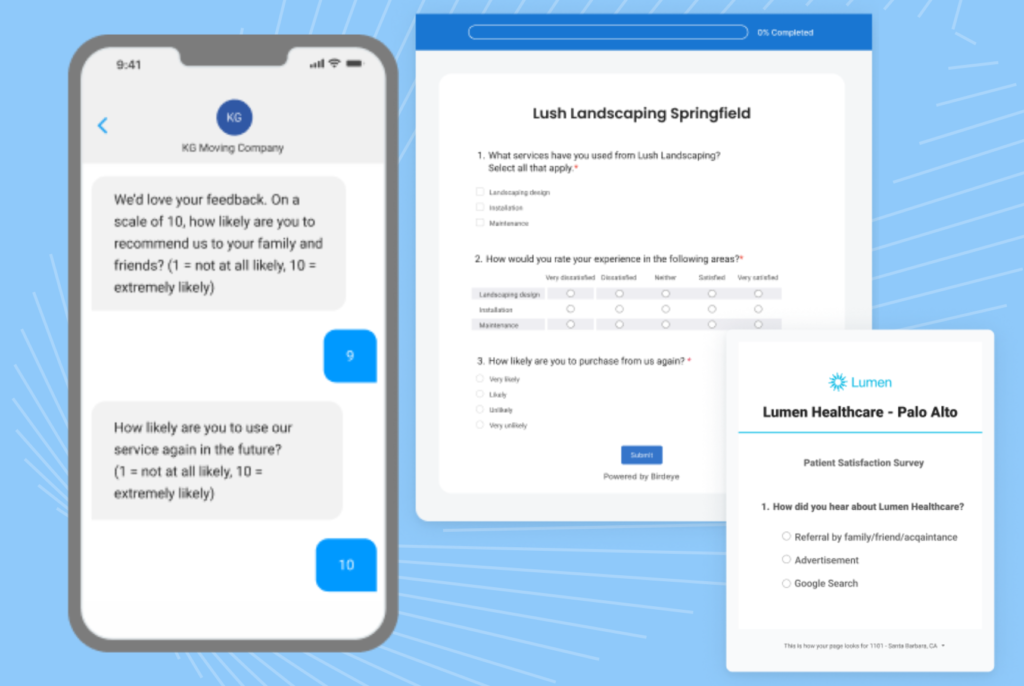
5 Best practices for customer satisfaction
A. Setting realistic customer expectations
You’re the one setting the tone. The best business practice is always to underpromise and overdeliver.
B. Providing proactive customer support
If you can anticipate customer needs, you can offer support before they’ve even asked for it, improving your overall reputation and customer retention.
C. Ensuring prompt response and resolution
Prioritize technical support queries, support tickets, live chat responses, and the like. And commit to offering a response and resolution to your customers as much as possible.
Customers are more likely to post negative reviews and report your business if the persistent issue affects their ability to use or enjoy the product.
D. Offering incentives for customer feedback
If you’ve been finding it difficult to get sufficient customer responses, incentivizing feedback can help increase engagement.
E. Continuously monitoring and measuring customer satisfaction
Customer satisfaction, for better or worse, is not a “one-and-done” job. You must commit to monitoring, measuring, and improving ongoingly.

2 CSAT alternatives: CES & NPS
While the CSAT score is a widely used metric, several alternative methods exist to measure customer experience and satisfaction. These alternatives offer different perspectives and insights into customer sentiments. Here are some popular CSAT alternatives:
What is CES?
Customer Effort Score (CES) evaluates the ease of the customer’s experience when interacting with a company, such as resolving an issue or completing a transaction.
Customers rate the effort they put in on a scale, usually from “very easy” to “very difficult.”
CES advantages and disadvantages
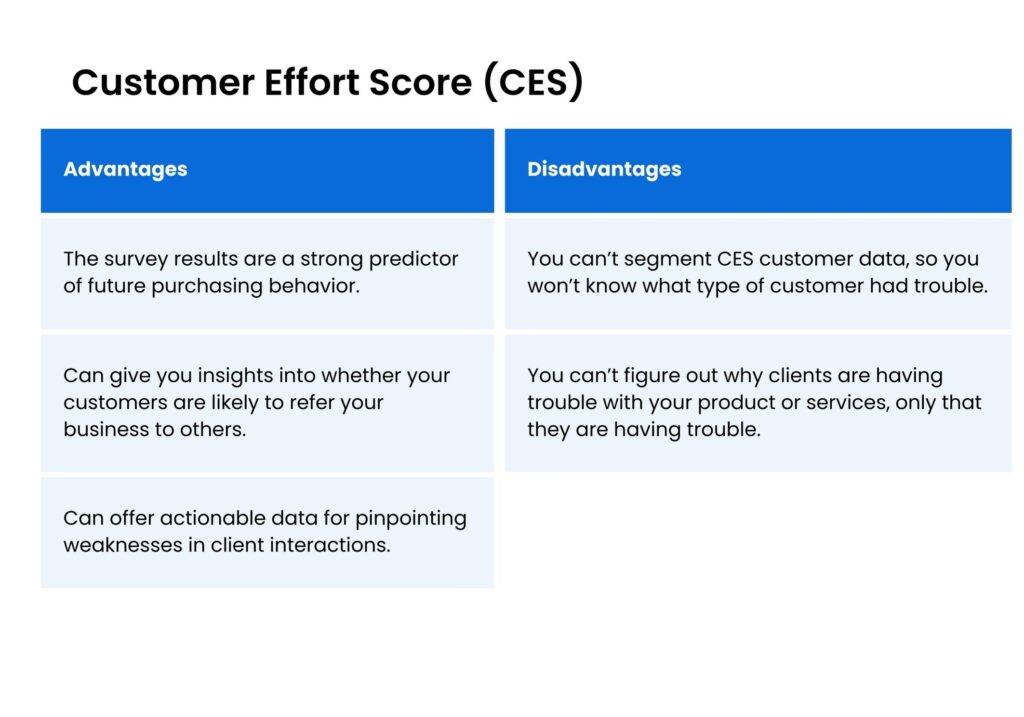
What is NPS?
Net Promoter Score (NPS) measures customer loyalty and gauges the likelihood of customers recommending a company to others. Customers are asked to rate on a scale of 0 to 10 how likely they are to recommend the company.
This metric categorizes respondents into Promoters (score 9-10), Passives (score 7-8), and Detractors (score 0-6).
NPS advantages and disadvantages
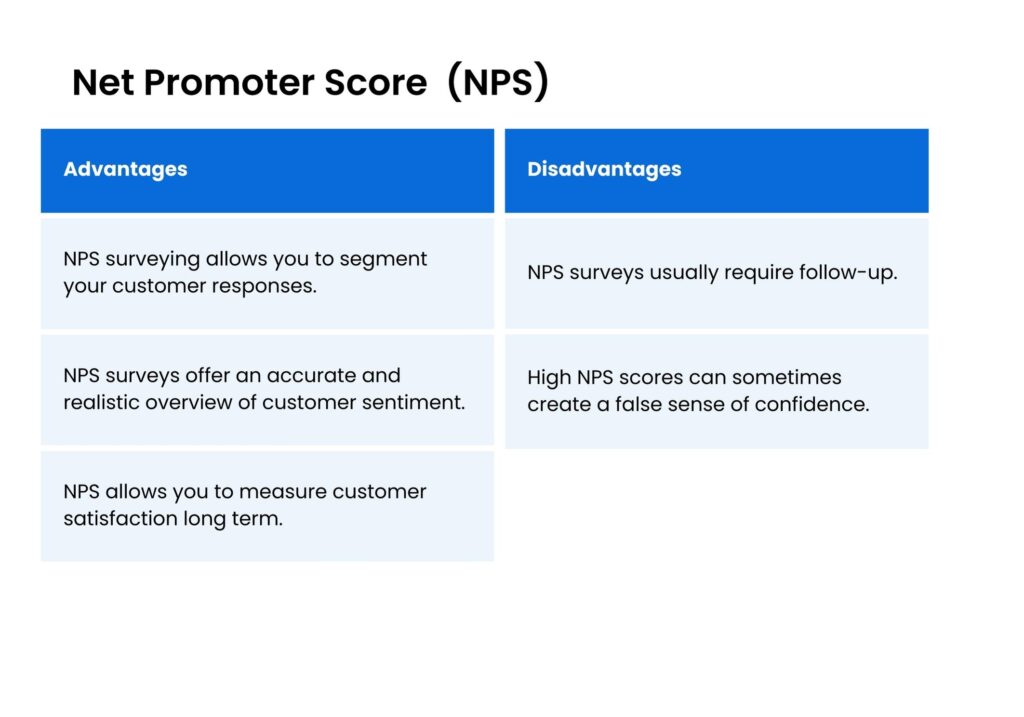
How to use CSAT as your differentiator?
Create your CSAT survey
Set your objectives. Ask about your customer’s overall satisfaction, but keep the survey short and simple. If possible, avoid the use of open-ended questions.
Customize the CSAT question
Use CSAT questions that are relevant to the situation. The following questions are among the most common:
- “How satisfied were you with the customer experience you received from us today?”
- “If you are less than totally satisfied, what could we do to serve you better?”
- “How satisfied are you with our product or service?”
Open-ended responses
Limit the number of open-ended questions you use. Only use open-ended questions when no other questions work or if collecting the feedback would benefit your business.

How to quantify CSAT in open-ended responses?
Open-ended responses may only be useful in deeper customer feedback analysis. Ideally, you would always collect open-ended and closed-ended questions indicating a customer’s overall satisfaction level.
Case study of customer satisfaction done right with Birdeye
David’s Bridal was already selling dresses to one in three brides in the U.S. But they knew they could do better by increasing their customer feedback rate.
David’s Bridal used Surveys and other tools from Birdeye to triple their review volume and increase their NPS score from 19 to 73.
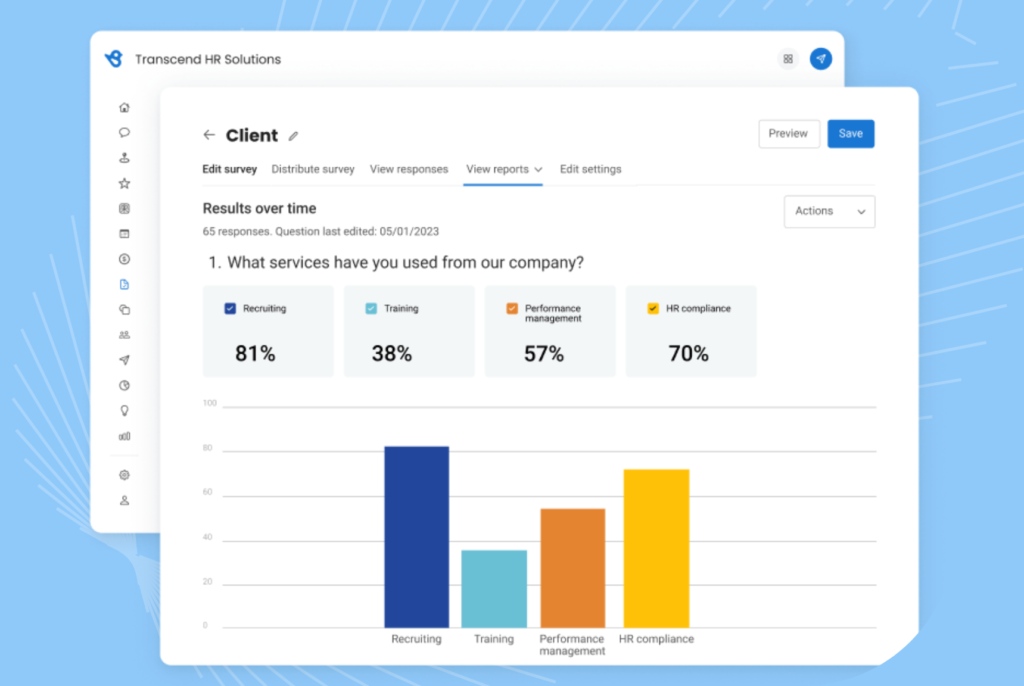
FAQs on customer satisfaction score
Collect responses from your customers. Divide the number of satisfied customers by the total number of responses received. Multiply the number by 100 to get your score, representing a percentage.
– CES – based on customers’ efforts to interact with your products and services.
– CSAT – measures customer satisfaction levels.
– NPS – helps you find out how likely customers are to recommend you to others.
This will depend on your industry benchmarks. A score of 70 to 80, however, is common among most.
Empower your employees. Give them the training and the tools they need to succeed in customer service.
Take advantage of technology. Use chatbots and other tools to keep connected to your customers 24/7/365.
Go omnichannel. Customers will communicate with you using a variety of channels, like email, social media, phone, and more. Stay on top of them.
Use a simple question like “How satisfied are you with the support you received today?” Give your customers unbiased, fair answers, from “very helpful” to “very unhelpful.”
Chatbots, live chat, support ticket systems, Customer Relationship Management (CMS) platforms, social media management tools, email marketing services, etc.
Scale your customer satisfaction with Birdeye Survey
Customer satisfaction score is a simple concept. Start using the tools available to collect answers from your customers now and plan to survey them regularly. Calculate your score, and create benchmarks you can measure future reporting against.

Originally published



